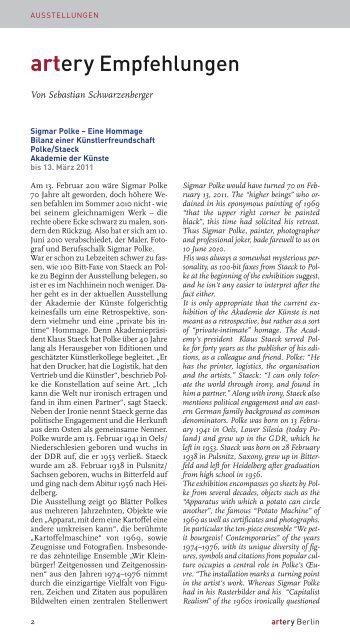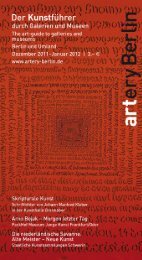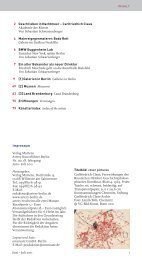artery Berlin
artery Berlin
artery Berlin
Erfolgreiche ePaper selbst erstellen
Machen Sie aus Ihren PDF Publikationen ein blätterbares Flipbook mit unserer einzigartigen Google optimierten e-Paper Software.
AUSSTELLUNGEN<br />
<strong>artery</strong> Empfehlungen<br />
Von Sebastian Schwarzenberger<br />
Sigmar Polke – Eine Hommage<br />
Bilanz einer Künstlerfreundschaft<br />
Polke/Staeck<br />
Akademie der Künste<br />
bis 13. März 2011<br />
Am 13. Februar 2011 wäre Sigmar Polke<br />
70 Jahre alt geworden, doch höhere Wesen<br />
befahlen im Sommer 2010 nicht - wie<br />
bei seinem gleichnamigen Werk – die<br />
rechte obere Ecke schwarz zu malen, sondern<br />
den Rückzug. Also hat er sich am 10.<br />
Juni 2010 verabschiedet, der Maler, Fotograf<br />
und Berufsschalk Sigmar Polke.<br />
War er schon zu Lebzeiten schwer zu fassen,<br />
wie 100 Bitt-Faxe von Staeck an Polke<br />
zu Beginn der Ausstellung belegen, so<br />
ist er es im Nachhinein noch weniger. Daher<br />
geht es in der aktuellen Ausstellung<br />
der Akademie der Künste folgerichtig<br />
keinesfalls um eine Retrospektive, sondern<br />
vielmehr und eine „private bis intime“<br />
Hommage. Denn Akademiepräsident<br />
Klaus Staeck hat Polke über 40 Jahre<br />
lang als Herausgeber von Editionen und<br />
geschätzter Künstlerkollege begleitet. „Er<br />
hat den Drucker, hat die Logistik, hat den<br />
Vertrieb und die Künstler“, beschrieb Polke<br />
die Konstellation auf seine Art. „Ich<br />
kann die Welt nur ironisch ertragen und<br />
fand in ihm einen Partner“, sagt Staeck.<br />
Neben der Ironie nennt Staeck gerne das<br />
politische Engagement und die Herkunft<br />
aus dem Osten als gemeinsame Nenner.<br />
Polke wurde am 13. Februar 1941 in Oels/<br />
Niederschlesien geboren und wuchs in<br />
der DDR auf, die er 1953 verließ. Staeck<br />
wurde am 28. Februar 1938 in Pulsnitz/<br />
Sachsen geboren, wuchs in Bitterfeld auf<br />
und ging nach dem Abitur 1956 nach Heidelberg.<br />
Die Ausstellung zeigt 90 Blätter Polkes<br />
aus mehreren Jahrzehnten, Objekte wie<br />
den „Apparat, mit dem eine Kartoffel eine<br />
andere umkreisen kann“, die berühmte<br />
„Kartoffelmaschine“ von 1969, sowie<br />
Zeugnisse und Fotografien. Insbesondere<br />
das zehnteilige Ensemble „Wir Kleinbürger!<br />
Zeitgenossen und Zeitgenossinnen“<br />
aus den Jahren 1974–1976 nimmt<br />
durch die einzigartige Vielfalt von Figuren,<br />
Zeichen und Zitaten aus populären<br />
Bildwelten einen zentralen Stellenwert<br />
2<br />
Sigmar Polke would have turned 70 on February<br />
13, 2011. The “higher beings” who ordained<br />
in his eponymous painting of 1969<br />
“that the upper right corner be painted<br />
black”, this time had solicited his retreat.<br />
Thus Sigmar Polke, painter, photographer<br />
and professional joker, bade farewell to us on<br />
10 June 2010.<br />
His was always a somewhat mysterious personality,<br />
as 100-bit faxes from Staeck to Polke<br />
at the beginning of the exhibition suggest,<br />
and he isn't any easier to interpret after the<br />
fact either.<br />
It is only appropriate that the current exhibition<br />
of the Akademie der Künste is not<br />
meant as a retrospective, but rather as a sort<br />
of “private-intimate” homage. The Academy's<br />
president Klaus Staeck served Polke<br />
for forty years as the publisher of his editions,<br />
as a colleague and friend. Polke: “He<br />
has the printer, logistics, the organisation<br />
and the artists.” Staeck: “I can only tolerate<br />
the world through irony, and found in<br />
him a partner.” Along with irony, Staeck also<br />
mentions political engagement and an eastern<br />
German family background as common<br />
denominators. Polke was born on 13 February<br />
1941 in Oels, Lower Silesia (today Poland)<br />
and grew up in the GDR, which he<br />
left in 1953. Staeck was born on 28 February<br />
1938 in Pulsnitz, Saxony, grew up in Bitterfeld<br />
and left for Heidelberg after graduation<br />
from high school in 1956.<br />
The exhibition encompasses 90 sheets by Polke<br />
from several decades, objects such as the<br />
“Apparatus with which a potato can circle<br />
another”, the famous “Potato Machine” of<br />
1969 as well as certificates and photographs.<br />
In particular the ten-piece ensemble “We petit<br />
bourgeois! Contemporaries” of the years<br />
1974–1976, with its unique diversity of figures,<br />
symbols and citations from popular culture<br />
occupies a central role in Polke's Œuvre.<br />
“The installation marks a turning point<br />
in the artist's work. Whereas Sigmar Polke<br />
had in his Rasterbilder and his “Capitalist<br />
Realism” of the 1960s ironically questioned<br />
<strong>artery</strong> <strong>Berlin</strong>




